Rauma lace-making
| Rauma lace-making | ||||
|---|---|---|---|---|
| In the national inventory | ||||
|
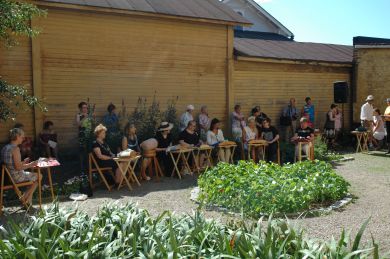
Practitioners and people who know the tradition well
"Such lace," says a Rauma girl, when she sees a spider's web."(org. ”Tommost pitsi, sanos Rauma Flik, ko hämhäki verko näk.”)
The tradition of lace-making in Rauma is a living heritage, and the skill is passed down as an oral tradition from one generation to the next. In the town, both traditional Rauma lace, which is continuous-thread lace made from linen yarn, and new creative lace with a foundation in the old tradition, are created simultaneously. According to the Rauma way of thinking, one must know the tradition before deviating from it.
Lace-making takes place throughout Finland, but Rauma has centuries-old traditions in this craft. The tradition is practiced in Rauma both collectively and organized, as well as individually within the home. In Rauma, everyone is allowed to make lace, and according to oral tradition, even men have always made lace here, although often discreetly within the walls of their homes. Today, the majority of individuals engaged in organized lace-making and carrying on the tradition are women. However, history also knows of a few men dedicated to Rauma lace-making and even actively participating in lace-making. Nevertheless, all known historically recognized professional lace-makers have been women, connecting contemporary practitioners to the long line of Rauma lace-making mothers.
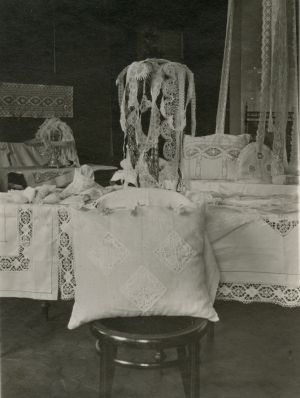
Rauma has two registered associations dedicated to lace-making: Nyplääjät ry and Pitsikeskus Emelia ry. The founding meeting of Nyplääjät ry took place in 1948, and its activities began the following year. The association currently has 199 members. In 1982, the association changed its name to Nyplääjät ry. Over the years, the association has produced guides and pattern books for Rauma bobbin lace. The association publishes the Knypyläviesti magazine annually. The association owns a lace supplies shop called Pits-Priia located in the Old Rauma World Heritage Site, which is of significant importance to lace-makers throughout the town. Pits-Priia is open year-round on Saturdays and daily during the summer, staffed by knowledgeable lace-makers who can provide guidance. The shop also offers guided visits outside regular opening hours. Nyplääjät ry members regularly conduct short courses for small groups and introduce lace-making in local schools. Nyplääjät ry was one of the founding organizations of Rauma Lace Week in 1971 and continues to provide exhibitions and lace-making guidance for the event. Pitsikeskus Emelia ry was established in 2001, with activities beginning in 2002. The association currently has 65 members. Pitsikeskus Emelia's activities are focused on modern lace-making. The association has published a booklet about a master lace-maker from Rauma, Impi Emelia Alanko, and has been involved in producing other publications about Rauma lace-making traditions. Pitsikeskus Emelia ry selects the Lace-maker of the Year annually and organizes exhibitions and the Fastest Lace-Maker competition during Rauma Lace Week. Additionally, Pitsikeskus Emelia has organized a lace-making circle for elementary school-aged children for several years. Lace-making classes are offered in Rauma through the Rauma Adult Education Center. Courses are available for beginners and more advanced learners, as well as specialized courses on various topics, such as lace design.
Practising of the tradition
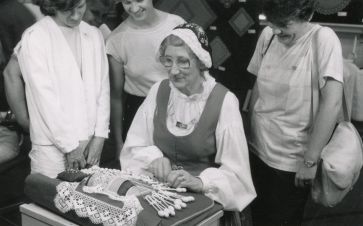
Rauma lace belongs to the true laces, which include both bobbin and needle lace. Rauma lace is handcrafted, relying on centuries-old traditions and knowledge, and the tools used have remained quite similar for a long time. The tradition of lace-making in Rauma is based on Western European traditions. The process of lace-making begins with the preparation of tools and materials. Rauma lace is crafted on a semi-circular pillow designed for lace-making. The pillow's frame is made of wood, traditionally filled with sea grass or woodworker's wood shavings. Nowadays, foam rubber is commonly used as filling. The pillow is covered with fabric and has a straight side with an opening where a cylindrical roller is placed to rotate along its longitudinal axis. An additional hook prevents the roller from rotating uncontrollably. The wooden roller's axis is covered with several rounds of fabric as padding, where the lace pattern, known as "mynster" in Rauma dialect, is attached with pins. Originally, mynster patterns were made on parchment made from animal skin. Later, cardboard became the preferred material. Holes were pierced in the parchment or cardboard, and often, guide lines were drawn. The holes represent the positions for pins, and the lines indicate the path of thread pairs in the lace. Typically, flax thread is used in lace-making, and it is twisted onto wooden bobbins, known as "knypyläs" in Rauma. To start making lace, one thread from each pair is twisted into two separate knypyläs, forming a pair.
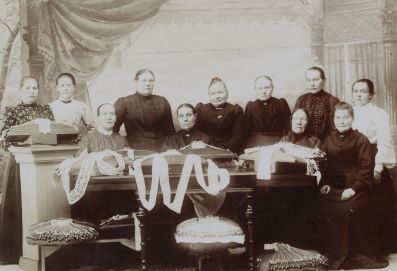
Lace-making is based on two fundamental moves involving the two pairs: "crossing" and "twisting." In a "crossing" move, the right knypylä of the left pair is moved over one thread to the right, effectively switching the knypylä from one pair to the other. A "twist" is made within the same pair, where the right knypylä is moved over the left knypylä. Often, both pairs are twisted simultaneously. When these two moves, crossing and twisting, are combined, they form the basic actions, referred to as "strokes" in lace-making. There are three fundamental strokes: the half-stroke, the linen stitch, and the full-stroke. Additionally, strokes can be modified by using variations in the moves. The lace-maker progresses by following the mynster's lines or by memorizing the pattern. However, the mynster does not explicitly indicate which strokes to use at each point. Traditionally, lace-makers have examined finished lace to learn how each section was made. With the invention of photocopiers, photocopies of finished lace have often been used as a reference. It is common, both in the past and today, for a novice to be guided by an experienced lace-maker who shows them how each part is made. This way, the technique is passed down orally, and the novice memorizes the method. Eventually, they may pass on their knowledge orally to the next generation. When the lace reaches the desired length, the lace-maker either cuts the threads and removes the lace from the pillow roller or connects the starting and ending points while the lace is still attached to the roller. The lace-maker's work does not end there, as often there is the additional step of attaching the lace to fabric. Part of the Rauma lace-making tradition involves attaching the lace to fabric, and items like tablecloths are not entirely made by lace-making. Instead, lace is used to create various lace elements, such as edges, which are then attached to the fabric following traditional methods.
Rauma lace-making began with fine linen thread used for clothing and accessories in the 18th century. Due to changing fashion trends, thicker thread was used to create lace for interior decorations such as tablecloths, sheets, and curtain edgings. Occasionally, lace collars and decorations for christening gowns were also made. In the 20th century, tablecloths took on the most prominent role, and lace-makers also consider these to be the traditional Rauma lace, even though the so-called original Rauma lace was mainly used for bonnets and other accessories. The economic significance of lace-making for individuals in Rauma has diminished throughout the 20th century, and no one has made a full living from it for quite some time. However, lace is still crafted for sale, and income is earned from teaching lace-making. So, this aspect of lace-making has not disappeared entirely. In recent years, artistic individual expression has become more prominent in Rauma lace-making. Lace-making has been used as a technique in creating art pieces, and lace itself has been incorporated into works of art. Skilled and creative lace-makers have been designing new lace patterns and products for some time.
The background and history of the tradition
Lace has been made in other parts of Finland as well, but Rauma is the only place where lace was professionally and continuously crafted according to fashion trends, and the tradition has remained unbroken to this day. There is no precise information about when or how lace-making began in Rauma, but according to written sources, lace-making in Rauma was already being done quite professionally in the mid-1700s. Local production likely gained momentum due to mercantilist economic policies, including import bans on luxury goods, which also applied to lace. Importing lace was completely prohibited in 1731.
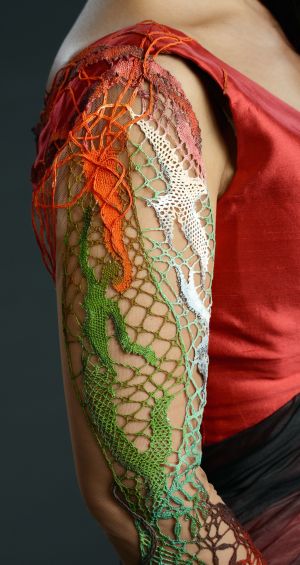
The oldest documentary sources about lace-making in Rauma date back to the mid-1700s. In the Rauma Museum local history archive, there is a document that is a public notice intended to be read in church. It dates back to between 1747 and 1750, and it requests information about a lace-making pillow that had fallen from a sled. Governor Juhani Yrjö Lillenberg of the Turku and Pori Province made proposals in the minutes of a meeting of the Stockholm Manufacturing Office on May 31, 1750, to improve the conditions of Rauma lace-makers. According to Lillenberg, the Rauma lace-makers had already progressed considerably in their skills and produced a significant amount of inexpensive lace annually. A few years later, Lillenberg mentioned that 4,000 ells of lace had been made in Rauma, which was sold in rural areas. In 1832, there were 397 professional lace-makers in Rauma.
The first flourishing period of Rauma lace, specifically fine ground lace used for bonnets, occurred from the mid-1700s to the 1840s. In 1807, it was reported that Rauma lace was exported to Sweden, Norway, Russia, and Denmark. By 1832, the export area had mostly shrunk to cover almost exclusively domestic markets, especially in the Ostrobothnia region. Changes in fashion and market saturation reduced the demand for bonnet lace. The Finnish Economic Society started promoting Rauma lace-making at this stage. Previously, most patterns had come from the Netherlands, but now the focus shifted to the Saxon region. The Finnish Economic Society was even willing to send a lace-maker from Rauma to Saxony for training, but no one from Rauma was willing to go. Instead, the city hoped for good lace-making thread and foreign patterns. Lace-making thread and a pattern book containing about 200 patterns were obtained. In the local context, lace was starting to be made for home textiles such as cushions and tablecloths, using thicker thread than the previous fine ground lace. These lace pieces had a folk-style known as "Torchon lace," which was made in various parts of Europe. Starting in the 1840s, lace-making began to decline in Rauma as the century progressed. The demand for lace decreased, and new lace-makers were not eager to enter a field with poor income and demanding, time-consuming work.
In 1902, the architect Carl Frankenhaeuser visited the city and became acquainted with lace-making. Afterward, he, together with his mother Thella Frankenhaeuser, started to revive the tradition of Rauma lace-making. At that time, there were only 21 professional lace-makers left in Rauma. Thella Frankenhaeuser, in particular, became a significant patron of Rauma lace. It can be confidently said that without her contribution, Rauma lace would not have survived as a tradition during that challenging period. Thella Frankenhaeuser acted as a unifier of Rauma lace-makers by organizing coffee gatherings, visiting elderly lace-makers, and using other means to pass on the knowledge and skills of these old masters to younger generations. To this day, Thella's coffees continue during the Lace Week, bringing lace-makers together for relaxed social gatherings. Mrs. Frankenhaeuser bought and sold Rauma lace in Finland's major cities, organized lace sales exhibitions, and, perhaps most significantly, helped Rauma lace-makers develop new, more marketable patterns alongside the lace sold by the meter.
The transmission of the tradition
The tradition of lace-making in Rauma is a living cultural heritage that anyone can encounter and become inspired by. Passing on this tradition successfully requires finding a bearer of the tradition who is willing to share it with someone passionate about it.
The visibility of lace and lace-making in Rauma throughout the year plays a significant role in passing on the tradition. The most prominent event is the annual Rauma Lace Week held in July. The lace-making association Nyplääjät ry's lace store is open year-round, as is the basic exhibition at the Rauma Museum, which presents the lace-making tradition. The core of the merchandise in the museum shop Kistupuad consists of local handmade lace and various lace-related products. Lace is also visible to some extent in the cityscape, as decorative elements on buildings and in public art. Lace-making is introduced to students as part of the local cultural education program. Locals have relatively easy access to becoming familiar with lace-making at the moment.
Lace-making in Rauma is taught from one generation to another within families, but nowadays, it is more common to learn the skill through organized courses. Approximately 100 people participate in courses organized by the Rauma Adult Education Center annually. Attempts to start lace-making schools in Rauma date back to the 1840s, but due to the lack of students and the decreasing demand for lace, the school operated here for only two years. The next time a lace-making school was established in Rauma was in 1908. Even though this school's operations lasted only a few years, it introduced nearly 80 students to the intricacies of lace-making. This had a significant impact on passing on the tradition from the experienced lace-makers of the 1800s to younger generations, contributing to the tradition's preservation.
In 1919, with funding from Kotiteollisuus OY Pirtti, a follow-up course in lace-making was organized for young professionals. With the financial support from Alfred Kordelin's testamentary donation aimed at reviving home crafts, the Yleinen käsiteollisuusyhditys established a committee in Rauma to handle lace-making matters. The committee decided to specifically organize lace-making courses. The first courses began in 1920, lasting six weeks with 55 participants. Between 1921 and 1939, two similar courses were held annually. The Winter War interrupted the third course, and education was put on hold during the war. However, the Lace Committee continued its activities during the war, providing Rauma lace-makers with threads and commissioning lace pieces for sale in Helsinki. Lace-making instruction at Rauma Adult Education Center started in 1947 and has continued since then.
Today, one can also explore the secrets of lace-making through internet websites. For over 10 years, the Rauma Lace website has provided texts and instructional videos, allowing many to learn the art of lace-making. They too represent the tradition of Rauma lace-making, even if they do not reside here.
The future of the tradition
The future of the tradition looks promising. The tradition of lace-making in Rauma and lace itself are an integral part of the Rauma identity and are also nationally recognized and acknowledged. The lace tradition is considered unique and is highly valued locally, even among those who do not actively practice it or have no personal connection to it in their daily lives. However, the current situation should not be taken for granted, and efforts to preserve the tradition must be ongoing. Presenting the tradition, providing accessible opportunities for people to learn about it, and, above all, educational initiatives aimed at schoolchildren are crucial for maintaining the tradition's vitality. Additionally, the positive attitude of the City of Rauma towards incorporating lace into the cityscape and public art contributes to the tradition. The city and local businesses use lace as a graphic element in their communication and in the decoration of commercial spaces, further bringing the tradition to the forefront. Fortunately, there have been and continue to be passionate advocates for lace-making in the community, whose work over the decades has ensured the well-deserved recognition of this magnificent craft in various ways. Sometimes, the work of even a single individual can have far-reaching consequences. External interest, as demonstrated by Mrs. Thella Frankenhaeuser's example, can also help the tradition thrive and endure. However, the responsibility for preserving the tradition as a living heritage ultimately lies with us, the carriers of the tradition in Rauma.
The community/communities behind this submission
Rauman kaupunki, Kulttuuri- ja museopalvelut, Rauman museo
Bibliography and links to external sources of information
Tutustu raumalaiseen nyplätyn pitsin perinteeseen, löydät myös opetusvideoita
Online sources
ISIEN TYÖT - Kansatieteellisen Filmi Oy:n lyhytelokuvia vuosilta 1936-39
Yle Areena/Ylen aamu , "Moderni nyplääjä koristelee pitsillä vaikka tennarit" (22.7.2019)
Yle Areena/Yle Uutiset Keski-Suomi ja Etelä-Savo, "Yle Uutiset Keski-Suomi: Tarmo nyplää pitsistä omakuvaa" (30.10.2015)
Practitioners web pages
Bibliography
Hella, Tenho 1998. Raumalaista käsityö- ja teollisuusperinnettä.
Honka-Hallila, Helena 2012. Suomalaista nyplättyä pitsiä.
Honka-Hallila, Helena ja Jalonen, Sirkka (toim.) 2014. Pitsiaarteita aikojen takaa. Tykkimyssyt ja niiden pitsit.
Honka-Hallila, Helena 2015. Ristiin kierto. Pitsinnypläys ammattikäsityöstä harrastukseksi.
Honka-Hallila Helena ja Vänni, Pirkko 2017. Raumanpitsien aatelia.
Lindholm, Idi 1947. Pitsikirja. Aitopitsit ja verkkopitsit.
Linnove, Aino 1947. Suomalaisen pitsinnypläyksen kehitysvaiheita 1500-luvulta 1850-luvulle Linnove, Aino 1963. Suomalaiset nyplätyt pitsit.
Lähteenoja, Aina 1935. Kuuluisimmat Rauman naiset ovat pitsinnyplääjiä. Kotiliesi.
Lähteenoja, Aina 1939. Rauman kaupungin historia VI.
Nurmi-Nielsen, Anna 1999. Raumanpitsi – Rauma lace.
Pitsityöryhmä Manuela 2001. Vanhoja Raumalaisia tyllipitsejä. Stjernuddi.
Pitsityöryhmä Manuela 2002. Vanhoja Raumalaisia tyllipitsejä. Ristnippu.
Thorström, Tarmo 2019. Moderni pitsinnypläys.
Vartiainen, Hannu 2016. Rauman merenkulun historia.
Östman, John 1971. Rauman pitsinnypläys. Kotiteollisuus 6.
Östman, John 1972. Raumanpitsit. Vakkanen. Kalevalaisten naisten vuosikirja.
Unpublished sources
Palo, Marketta 1989. Frimodiglai –niminen nyplätty pitsi. Tekstiiliopin syventävien opintojen tutkielma. Kasvatustieteen osasto, käsityönopettajien koulutuslinja, Helsingin yliopisto.
Tulosmaa, Liisa 2013. Henkilökuva mestarinyplääjä Johanna Sabina (Biinu) Lundströmistä. Käsityöläisnaisen elämä raumalaisessa kontekstissa 1800-luvun lopulta 1940-luvulle. Käsityötieteen pro gradu-tutkielma, Filosofinen tiedekunta, Soveltavan kasvatustieteen ja opettajankoulutuksen laitos, Itä-Suomen yliopisto.
